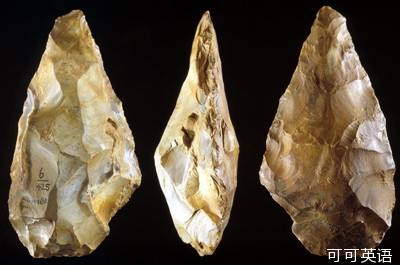The stone has been chipped to give you sharp edges along the long sides of the tear-drop, so to speak, and to give you a sharp point at one end. When you hold it up against a human hand, you are struck by how closely it matches the shape, although this one is unusually large and it is bigger than most human hands would be. It's also been very beautifully worked, and you can see the marks of the chipping that have shaped it.
這樣說(shuō)吧,沿著淚珠狀長(zhǎng)長(zhǎng)的側(cè)面,石頭被打磨得邊緣頗為鋒利,同時(shí)在一個(gè)端頭給你打磨出尖端。當(dāng)人類的手握住它時(shí),它的形狀與人手之完美匹配,將給你留下深刻的印象;盡管這一塊出乎尋常的大,比絕大多數(shù)人手大得多。同時(shí),它卻是一塊鬼斧神工的精品,你可以細(xì)細(xì)觀察那些塑造出它的打磨痕跡。
A handaxe like this was the Swiss Army knife of the Stone Age - an essential piece of technology with multiple uses. The pointed end could of course be used as a drill, while the long blades on either side would cut trees or meat or scrape bark or skins. You can imagine using this to butcher an elephant, to cut the hide and remove the meat.
諸如以類的手斧就是石器時(shí)代的瑞士軍刀,一種多功能多用途的必備良品。那尖端的一邊肯定可以當(dāng)成鉆頭,而兩邊長(zhǎng)長(zhǎng)的鋒利邊緣則可以用來(lái)伐樹(shù)割肉,或者刮樹(shù)皮扒獸皮。你可以想象一下用它來(lái)屠宰一頭大象,扒皮卸肉。
The very earliest tools, like the stone chopper we were looking at in the last programme, would strike all of us as pretty rudimentary. They look like chipped cobbles, and they were made simply by taking one large piece of stone and striking it with another, chipping off a few bits to make at least one sharp cutting edge.
那些最早的工具,如我們上期節(jié)目介紹過(guò)的石制砍砸器,讓我們的感覺(jué)是相當(dāng)之簡(jiǎn)陋。它們外表看來(lái)就像一顆顆稍稍錘擊過(guò)的鵝卵石,而且它們制作簡(jiǎn)單,通常就是拿兩顆石頭互相錘擊,至少把一端錘打出一個(gè)尖銳的邊緣出來(lái)。
But this handaxe is a very different matter. This is the expert stone-knapper, Phil Harding:
但是制作這種手斧卻完完全全是另一回事了。這是石器專家菲爾·哈丁:
'Now you can see, here I've selected a piece of flint which is relatively long and thin - not a great deal of work to thin it down.
“現(xiàn)在你瞧瞧,這兒呢,我挑了塊燧石,比較細(xì)長(zhǎng)的,要削薄下來(lái)工作量并不大。”
'And what I do is, I select a hard stone hammer, in this case a quartzite pebble about the size of a cricket ball, and I elect to hit it in one place - and this is where I start to knap. Now once I've taken one flake off, what I do then is turn the flint over and I take a flake off the other side, and then I turn it back again, and pretty much, by the time I've got all the way round, you can actually see that what I've done is make a very crude form of the final implement. It is rounded and it's got flaking on both sides but, crucially, it's got a cutting edge that goes all the way round.'
“我要做的就是,選擇一塊夠硬的石錘,這次我選這塊是個(gè)頭有板球大小的石英巖卵石。先挑個(gè)地方錘下去,接著我就開(kāi)始從這地方開(kāi)始鑿了。現(xiàn)在呢,一旦我鑿下一片碎片,我就換邊在另一邊也鑿下一片,如此反復(fù)。等我兩邊都忙完一遍下來(lái),你就可以清楚地看見(jiàn)我手中這物品已經(jīng)輪廓清晰,基本成型了。它是滿粗糙的,兩邊也很多缺口,但關(guān)鍵是它兩邊延伸下來(lái)的邊緣都是鋒利。”
Simply watching a practised knapper at work shows just how many skills the maker of our handaxe must have possessed. Handaxes are not things you knock off; they are the result of experience, of careful planning and of skill, learned and refined over a long period.
僅僅觀看一個(gè)熟手石器專家工作,就想而知我們這把石斧的制造者得擁有多高的技藝了。石斧可不是你亂鑿一通就可以整出來(lái)的東西,它們可是經(jīng)驗(yàn)的成果,凝結(jié)著精心設(shè)計(jì)與高超技藝,這些都得通過(guò)一段相當(dāng)長(zhǎng)期的學(xué)習(xí)與提升。












